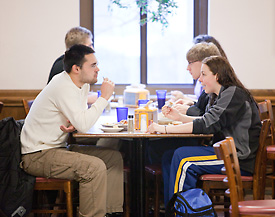More online
The university has launched a new Sustainability Web site to showcase its ongoing achievements in sustainability research, teaching and university operations, as well as to raise campus awareness of — and engagement in — sustainability issues and activities: www.sustainability.umich.edu
Students standing in line for dinner in the East Quad Dining Hall on a recent Sunday evening went to reach for a tray to hold their Cajun tofu pasta, veggie baked beans, scalloped potatoes and ice cream sundaes — only to find them conspicuously absent. As they meandered into the serving area, they noticed a sign saying, “Try Trayless Today!”
The trayless dining experience was spearheaded by students enrolled in a U-M class, Sustainability and the Campus, that requires students to participate in projects to make the university a more environmentally sustainable place. That goal is in line with President Mary Sue Coleman’s recently announced sustainability initiative to reduce the university’s carbon footprint. In the class, taught by Mike Shriberg, 42 students are working on eight different projects.
The concept behind trayless dining is that not having to wash trays means reducing waste substantially, by cutting back on water and detergent used in dishwashers, as well as energy for heating water and running equipment. Other colleges that have implemented the program have seen their water and detergent use drop substantially, along with decreased food waste, resulting in significant cost savings.
Will Moyer, a 20-year-old student participating in the project, was attracted to this initiative because he says it provides a relatively easy solution to reducing waste. “I thought this was a quick way to make a big difference,” he says. In addition to the energy savings, he says that trayless dining makes it tougher for students to balance several dishes at a time. So they don’t take more than they want, or will consume, reducing the food waste problem.

A Sustainability and the Campus class project recently introduced trayless dining to residents at East Quad Dining Hall. The project’s goal is to make U-M a more environmentally sustainable institution. Photo by Austin Thomason, U-M Photo Services.
East Quad’s lead chef, Buzz Cummings, says he often sees sandwiches heading to the trash that didn’t have a bite taken out of them, along with entirely uneaten apples and bananas. Once food is taken and discarded, “there’s not much we can do with it. This may help with that,” he says.
A pilot project conducted at Markley dining hall reduced food waste 50 pounds, pointing to a possible reduction of 50 pounds of food waste per person over the course of a full year, but the trial concluded just as the dining hall was closing for the academic year. Students hope this project will lead to more permanent results and felt aiming it at East Quad, which has an eco-friendly reputation, was more appropriate.
Laura Johnson, age 24, and an East Quad hall director, says, “The residents are very environmentally conscious and have a sense of what it means to change their behavior in order to bring about greater good.” Students surveyed residents about trayless dining as they exited the dining hall and weighed the waste being generated before and after the project to determine how much waste was reduced.
Many students trying trayless, including Kevin Farshchi, an 18-year-old freshman, were supportive. “I think it’s necessary and good for the environment,” he says. But Rachel England, a 19-year-old sophomore, said it’s difficult to fit all her food on one plate, so she opted to use a tray to avoid having to frequently return to the line, something she saw as a big inconvenience.
Overall, survey results showed most students willingly participated, and waste was reduced by 38 percent. Almost 100 percent of students went trayless at breakfast, 85 percent at lunch and 60 percent to 70 percent at dinner, says East Quad Dining Manager Sue Davis-Hyellsted. The system isn’t perfect, Davis-Hyellsted says. The tables were messier, since trays tend to catch spills, so staff had to spend more time wiping them down — a challenge during busy meal times. Also, East Quad has carts best equipped for stacking trays, and dishes would topple when the cart was moved. She said this isn’t insurmountable, and that a system that better handles dishes would improve the situation.
A post-survey of 100 students assessed if students continued going trayless. It found that 81 percent of residents decreased their use of trays, while 40 percent of that 81 percent have stopped using trays altogether. “Every tray counts … I think it has been a success,” says Stephanie Wither, a 20-year-old junior who said this project was an invaluable part of her U-M experience. The students are preparing a report for University Housing recommending that East Quad become trayless, ideally by this summer, along with suggestions for an easier transition to trayless dining.
The biggest obstacle will be changing student behavior, since grabbing a tray is second nature, says Angela Bozell, a 20-year-old junior in the group. But as new students arrive and never see trays, “they’ll be less likely to want one,” she says. If it is implemented, “I would feel very satisfied that our hard work paid off,” she says.

